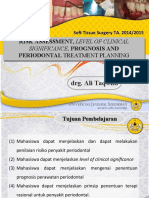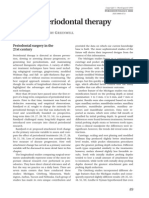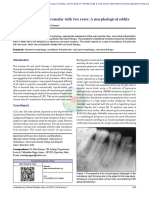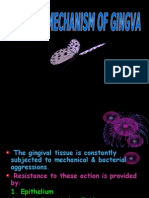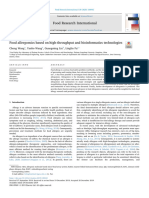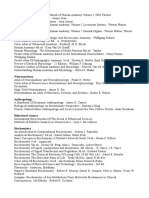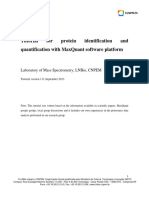08 - Salivary Biomarkers A Periodontal Overview
08 - Salivary Biomarkers A Periodontal Overview
Uploaded by
FisaCopyright:
Available Formats
08 - Salivary Biomarkers A Periodontal Overview
08 - Salivary Biomarkers A Periodontal Overview
Uploaded by
FisaOriginal Title
Copyright
Available Formats
Share this document
Did you find this document useful?
Is this content inappropriate?
Copyright:
Available Formats
08 - Salivary Biomarkers A Periodontal Overview
08 - Salivary Biomarkers A Periodontal Overview
Uploaded by
FisaCopyright:
Available Formats
Journal of Oral Health & Community Dentistry
REVIEW ARTICLE
Salivary Biomarkers: A Periodontal Overview
Himanshu Khashu1, CS Baiju2, Sumidha Rohatgi Bansal3, Amit Chhillar4
ABSTRACT
The current clinical diagnostic criterias which were introduced almost half a century ago continue to function as the basis of oral diagnosis in todays clinical practice. Evolvement with time is now brought us to the era of biomarkers. Its a new paradigm for periodontal diagnosis which is of immense benefit in managing periodontitis patients. Biomarkers are tell tale molecules that can be used to monitor health status, disease onset, treatment response and outcome. These biomarkers can be obtained from blood components such as: serum or plasma. However because of its being an invasive procedure other body fluids such as saliva and GCF are being considered for potential source of biomarkers. The simple and non- invasive nature of saliva collection and its high sensitivity assay development has led to the salivary biomarkers being a promising future for periodontal diagnosis. Keywords: Biomarkers, Saliva, Proteomic
1 MDS Professor Sudha Rustagi College of Dental Sciences and Research, Faridabad, Haryana 2
MDS Professor and Head Sudha Rustagi College of Dental Sciences and Research, Faridabad, Haryana
3 MDS Reader Sudha Rustagi College of Dental Sciences and Research, Faridabad, Haryana 4 BDS PG Student Sudha Rustagi College of Dental Sciences and Research, Faridabad, Haryana
INTRODUCTION he second most common oral dis eases next to dental caries are the periodontal diseases which are considered to be inflammatory disorder that damages tissue through the complex interaction between periopathogens and the host defence systems (1).
tal pocket depth, attachment level, and plaque index, bleeding on probing and radiographic assessment of alveolar bone loss are still popular and universally used, however they are almost 50 years old and still act as basis for oral diagnosis till date. Saliva is simple, non-invasive, readily available and easily collected without specialized equipment or personnel. For the past two decades, saliva has been increasingly evaluated as a diagnostic fluid for detecting breast cancer (3), oral cancer (4), caries risk (5), salivary gland diseases (6), periodontitis (7), and systemic disorders such as hepatitis C and the presence of human immunodeficiency virus (HIV) (8). It may reflect levels of therapeutic, hormonal, and immunologic molecules and can yield diagnostic markers for infectious and neoplastic diseases. Various mediators of chronic inflammation and tissue destruction have been detected in whole saliva of patient with oral diseases. Also, for some diagnostic purposes, salivary biomarkers proved more useful than serum analysis. Salivary biomarkers have also been used to examine the effect of
Because of the increasing prevalence and associated co morbidities (2), screening and diagnostic modalities for the early identification of oral disease initiation and progression, as well as objective measures for response to therapy, are being sought. A biomarker, or biological marker, is in general a substance used as an indicator of a biological state In oral diagnostics, it has been a great challenge to determine biomarkers for screening, prognosis and evaluating the disease activity and the efficacy of therapy (diagnostic tests). An oral diagnostic tool, in general, should provide pertinent information for differential diagnosis, localization of disease and severity of infection. Traditional diagnostic measures, such as visual examination, tactile appreciation, periodon-
Contact Author
Dr. Himanshu Khashu adhiman10@yahoo.co.in
J Oral Health Comm Dent 2012;6(1)28-33
28
JOHCD
www.johcd.org
January 2012;6(1)
SALIVARY BIOMARKERS: A PERIODONTAL OVERVIEW
lifestyle factors, including smoking, on periodontal health. Why is a periodontal disease indicator needed??? The diagnosis of active phases of periodontal disease and the identification of patients at risk for active disease are challenges for clinical investigators and practitioners alike. Researchers are confronted with the need for innovative diagnostic tests that focus on the early recognition of the microbial challenge to the host (9). Optimal innovative approaches would correctly determine the presence of current disease activity, predict sites vulnerable for future breakdown and assess the response to periodontal interventions. A new paradigm for periodontal diagnosis would ultimately improve the clinical management of periodontal patients. POSSIBLE SALIVARY BIOMARKER Enzymes : Alkaline phosphatise, Amino peptidase, Trypsin, glucosidase, galactosidase, glucosidase, glucoronidase, Gelatinase, Esterase, Collagenase, Kininase Immunoglobulin: Ig A, Ig G, Ig M, sIg A Protein: Cystatin, Fibronectin, Lactoferrin, Vascular endothelial growth factors, Platelet activating factors, Epidermal growth factors Phenotypic marker: Epithelial keratin Host cell: Leukocytes (PMNS) Ion: Calcium Hormones: Cortisol Bacteria: A.a, P. gingivalis, P. intermedia, P. micros, C. rectus, T. denticola, B. forsythus, P. micros, mycoplasma Volatile compounds: Hydrogen sulphide, Methyl mercaptan, Picolines, pyridines SALIVARY PROTEOMICS FOR EXISTING PERIODONTAL DISEASES Proteomics is the study of proteins. Salivary proteomics stands for the study of protein in saliva, salivary proteomics can be used as a method to evaluate the disease process.
Variable amounts of blood, serum, serum products, GCF, electrolytes, epithelial and immune cells, microorganisms, bacterial degradation products, lipopolysaccharides, bronchial products and other foreign substances are present in whole saliva. This makes saliva, the best periodontal diagnostic tool. Saliva contains biomarkers specific for the unique physiological aspects of periodontitis, and qualitative changes in the composition of these biomarkers could be diagnostic. It contains a wide variety of periodontal proteomic markers from immunoglobulins to bone remodelling proteins. Interleukin (IL) 1 is a proinflammatory cytokine that stimulates the induction of adhesion molecules and other mediators which in turn facilitate and amplify the inflammatory response. Its levels correlated significantly with periodontal parameters after adjusting for the confounders. Moreover, combined levels of Il-1 and matrix metalloproteinase (MMP)-8 increased the risk of experiencing periodontal disease by 45 folds (10). MMPs: MMP-8 a key enzyme in extracellular collagen matrix degradation, derived predominantly from PMNs during acute stages of periodontal disease also correlated significantly with periodontal activity even after adjusting for the confounders, Moreover, its presence significantly increased the risk of periodontal disease (odds ratios in the 11.3-15.4 range)(10) . Strong correlations between MMP-8 and traditional periodontal diagnostic methods further support the contention that MMP-8 is not only an indicator of disease severity, but also disease activity. MMP-1 (interstitial collagenase) also appeared to be activated in periodontitis (10). Higher levels of other MMPs, including MMP-2, MMP-3 and MMP-9, were also reported in the saliva of patients affected by periodontitis. Immunoglobulin (Ig): Patients with periodontal disease are shown to have higher salivary concentrations of Ig A, Ig G and Ig M specific to periodontal pathogens compared with healthy pa-
tients (11).Also the values decrease significantly post treatment. Acid Phosphatase (ACP) and Alkaline Phosphatase (ALP): A significant positive correlation between salivary ACP and calculus formation has been found (12). It was found that mixed whole saliva of adult periodontitis patients revealed the highest enzyme activities with ALP than that of healthy individuals who revealed lowest enzyme activities (13). The increase in salivary ALP activity in periodontitis can be associated with alveolar bone loss, a key feature of periodontal disease. Esterase, Lysozyme, Lactoferrin: A statistically significant, positive correlation between salivary esterase and calculus formation (12) was found. It was found that the esterase activity of whole saliva was higher in individuals with periodontal disease than in periodontaly healthy subjects (13). Moreover periodontal treatment reduced its levels. Hence the efficacy of periodontal treatment may be readily monitored by changes in levels of activity of specific enzymes like esterase in whole saliva (14). Patients with low levels of lysozyme in saliva are more susceptible to plaque accumulation, which is considered a risk factor for periodontal disease. Lactoferrin is strongly up-regulated in mucosal secretions during gingival inflammation and is detected at a high concentration in saliva of patients with periodontal disease compared with healthy patients (15). Epithelial Keratins Epithelial cells from the lining of the oral cavity are found in saliva, but the contribution of crevicular or pocket epithelial cells to the total number of salivary epithelial cells is not known (16). To study epithelial cell function in periodontal disease and periodontal diagnosis, specific keratin antigens in saliva may be evaluated. Furthermore, detection of keratins by monoclonal antibodies may have diagnostic value in detection of epi-
JOHCD
www.johcd.org
January 2012;6(1)
29
SALIVARY BIOMARKERS: A PERIODONTAL OVERVIEW
thelial dysplasia, oral cancer, odontogenic cysts and tumours (17). It has been suggested that phenotypic markers for junctional and oral sulcular epithelia might eventually be used as indicators of periodontal disease. McLaughlin et al. demonstrated that the keratin concentration in GCF was significantly higher at sites exhibiting signs of gingivitis and periodontitis compared with healthy sites (18). Similar findings were not observed in saliva. Inflammatory Cells ] The number of leukocytes in saliva varies from person to person, and cell counts vary for an individual during the course of the day. The majority of salivary leukocytes enter the oral cavity via the gingival crevice (19). Studies in the late 1960s and the early 1970s examined the presence of leukocytes (orogranulocytes) in saliva. Klinkhammer et al. standardized collection and counting of leukocytes in saliva and developed the orogranulocytes migratory rate (OMR). The OMR was found to be correlated with gingival index. In an experimental gingivitis model, the number of granulocytes in saliva increased before the appearance of clinical gingivitis (20). In a study by Raeste et al. (1978), the OMR was determined with sequential mouth rinse sampling in periodontitis patients and controls. The results indicated that the OMR reflects the presence of oral inflammation, and the authors suggested that this measure can be used as a laboratory test. However conflicting results were reported by Cox et al. (1974). Occult blood in saliva in relation to gingival inflammation has also been examined using a homescreening test (21). According to the authors, this method demonstrated sensitivity of 75.9% and specificity of 90.5% for detection of gingival inflammation. Salivary Ions Calcium (Ca) is the ion that has been most intensely studied as a potential marker for periodontal disease in saliva. A high concentration of salivary Ca was correlated with good dental health in young adults, but
no relationship was detected with periodontal bone loss as measured from dental radiographs (22). In another study, salivary Ca, and the saliva Ca to phosphate ratio were higher in periodontitis- affected subjects in comparison to healthy controls (23). No differences between groups were found for flow rate and buffering capacity of saliva. Another study from the same investigators examined differences in salivary calcium levels and found higher concentration of Ca in whole stimulated saliva from the periodontitis patients (24). The authors concluded that an elevated Ca concentration in saliva was characteristic of patients with periodontitis. SERUM MARKERS IN SALIVA WITH POTENTIAL IMPORTANCE FOR PERIODONTAL DISEASE Studies have suggested that emotional stress is a risk factor for periodontitis (25). One mechanism proposed to account for the relationship is that elevated serum cortisol levels associated with emotional stress exert a strong inhibitory effect on the inflammatory process and immune response (26). The presence of cortisol in saliva has been recognized for more than 40 years. Recently, salivary cortisol levels were used to evaluate the role of emotional stress in periodontal disease (27). Higher salivary cortisol levels were detected in individuals exhibiting severe periodontitis, a high level of financial strain, and high emotion-focused coping, as compared to individuals with little or no periodontal disease, low financial strain, and low levels of emotion-focused coping (27). Bacteria Specific species of bacteria colonizing the subgingival environment have been implicated in the pathogenesis of periodontal disease (28). Consequently, studies have evaluated levels of bacteria in saliva in relation to periodontal status. It has been suggested that microorganisms in dental plaque can survive in saliva, and can utilize salivary components as a substrate. It was shown that saliva could serve as a growth
medium for oral Streptococcus species and A. Viscous. Bowden (1997) suggested that the number of bacterial cells for a given species in unstimulated saliva may indicate whether that microorganism is actively growing in plaque. De Jong et al. (1986) studied that, microorganisms from supragingival plaque were grown on saliva agar. When supragingival plaque was placed on saliva and blood agar plates, the composition of the microflora isolated from the plates were similar. The authors concluded that the supragingival microflora could utilize saliva as a complete nutrient source. Umeda et al. (1998) examined the presence of periodontopathic bacteria in whole saliva in relation to occurrence of the microorganisms in subgingival plaque. Using polymerase chain reaction, a fair agreement was found between the presence of P. gingivalis, Prevotella intermedia and T. denticola in whole saliva and in periodontal pocket samples. These 3 micro-organisms, in addition to Prevotella nigrescens, were detected more often in saliva than in the subgingival samples. It was also stated that accurate detection of A. actinomycetemcomitans and B forsythus in the oral cavity requires analysis of both whole saliva and periodontal pocket samples. The effect of plaque accumulation on the salivary counts of some dental plaque microorganisms was examined in 20 subjects who refrained from oral hygiene for 7 days. The large increase in the number of bacteria on the teeth was reflected by an increase in salivary counts of Actinomyces species. A highly significant correlation was found between S. Mutans level in dental plaque and the salivary level of this microorganism. Furthermore, in a study of 60 children aged 59 years, isolation, frequency and numbers of Mycoplasma species in saliva were consistently related to gingivitis scores, which supports an association of Mycoplasma and gingivitis in children (29). Salivary levels of periodontal pathogens were found to vary with periodontal status and as a result of treatment.
30
JOHCD
www.johcd.org
January 2012;6(1)
SALIVARY BIOMARKERS: A PERIODONTAL OVERVIEW
Salivary levels of A. actinomycetemcomitans, P. gingivalis, P. intermedia, Campylobacter rectus, and Peptostreptococcus micros were determined by bacterial culture and related to clinical periodontal status in 40 subjects with varying degrees of periodontitis (30). In a study of 15 patients with moderate to severe periodontitis, a decrease in the number of patients harbouring A. actinomycetemcomitans and P. gingivalis in saliva was noted after Scaling and root planing and surgery. An oral microbial rinse test (Oratest) was described by Rosenberg et al. (1989). In this study Oratest was found to be a simple method for estimating oral microbial levels. In a companion study (Tal & Rosenberg 1990), Oratest results were correlated with plaque index and gingival index scores, and the authors stated that this test provides a reliable estimate of gingival inflammation. Volatiles Volatile sulphur compounds, primarily hydrogen sulfide and methylmercaptan, are associated with oral malodour (31). Salivary volatiles have been suggested as possible diagnostic markers and contributory factors in periodontal disease. For example, pyridine and Picolines were found only in subjects with moderate to severe periodontitis. Furthermore, saliva seems to be a useful medium to evaluate oral malodour. A significant association between the BANA scores from saliva and oral malodour was found. In a study of self estimation of oral malodour, estimation of malodour based on saliva yielded a significant correlation with objective parameters (32). However, no specific association between levels of volatiles and periodontal status has been reported. Markers of Periodontal Soft Tissue Inflammation During the initiation of an inflammatory response in the periodontal connective tissue, numerous cytokines, such as prostaglandin E2, interleukin-1beta, interleukin-6 and tumour necrosis factor-alpha are released from cells of the junctional epithelia and from connective tissue fibroblasts, macrophages and polymorphonuclear leukocytes. Subsequently, enzymes such as
matrix metalloproteinase (MMP)-8, MMP9 and MMP-13 are produced by polymorphonuclear leukocytes and osteoclasts, leading to the degradation of connective tissue collagen and alveolar bone. During the inflammatory process, intercellular products are synthesized, released and diffuse towards the gingival sulcus or periodontal pocket. Prostaglandins are arachidonic acid metabolites composed of 10 classes, of which D, E, F, G, H and I are of main importance. Of this group, prostaglandin E2 is one of the most extensively studied mediators of periodontal disease activity, Prostaglandin E2 acts as a potent vasodilator and increases capillary permeability, which elicits clinical signs of redness and oedema. It also stimulates fibroblasts and osteoclasts to increase the production of MMPs (33). Markers of Alveolar Bone Loss Many different biomarkers associated with bone formation, resorption and turnover, such as alkaline Phosphatase, osteocalcin, osteonectin and collagen telopeptidases, have been evaluated in gingival Crevicular fluid and saliva (34). These mediators are associated with local bone metabolism (in the case of periodontitis) as well as with systemic conditions (such as osteoporosis or metastatic bone cancers). During progressive periodontal breakdown, gingival and periodontal ligament collagens are cleaved by host cell-derived interstitial collagenases. Also the level of MMP-8 was demonstrated to be highly elevated in saliva from patients with periodontal disease using a rapid point of- care micro fluidic device (35). The MMP-8 level is also elevated in peri-implant sulcular fluid from peri implantitis lesions (36). Collectively, these results show promise for the use of MMP-8 as a biomarker in the active phase of peri-implant disease. Gelatinase (MMP-9) is produced by neutrophils and degrades collagen intercellular ground substance. In a longitudinal study patients were asked to rinse and expectorate, providing subject-based instead
of site based gingival Crevicular fluid samples (37). When analyzed, a twofold increase in mean MMP-9 levels was reported in patients with progressive attachment loss. These results show that the future use of MMP-9 in oral fluid diagnostics may serve as a guide in periodontal treatment monitoring. Collagenase-3 or MMP-13 is another collagenolytic MMP with exceptionally wide substrate specificity. MMP-13 has also been implicated in peri-implantitis. It was concluded that elevated levels of both MMP-13 and MMP-8 correlated with irreversible perio-implant vertical bone loss around loosening dental implants (38). MMP- 13 may be useful for diagnosing, monitoring the course of periodontal disease and for tracking the efficacy of therapy (39). In brief, the studies assessing the role of gingival Crevicular fluid carboxyterminal telopeptide of type I collagen levels as a diagnostic marker of periodontal disease activity have produced promising results to date. Carboxyterminal telopeptide of type I collagen has been shown to be a promising predictor of both future alveolar bone and attachment loss. Also, the levels of carboxyterminal telopeptide of type I collagen were strongly correlated with clinical parameters and putative periodontal pathogens, and demonstrated significant reductions after periodontal therapy. Elevated serum osteocalcin levels have been found during periods of rapid bone turnover, such as in osteoporosis and multiple myeloma and during fracture repair. Therefore, studies have investigated the relationship between gingival Crevicular fluid osteocalcin levels and periodontal disease. When a combination of the biochemical markers osteocalcin, collagenase, prostaglandin E2, alpha-2 macroglobulin, elastases and alkaline phosphatise was evaluated, increased diagnostic sensitivity and specificity values of 80 and 91%, respectively, were reported (40).
JOHCD
www.johcd.org
January 2012;6(1)
31
SALIVARY BIOMARKERS: A PERIODONTAL OVERVIEW
Table 1: Specific and nonspecific markers in salivary glands
Marker SPECIFIC Immunoglobulin (Ig A, Ig M, Ig G) NON SPECIFIC Mucins Lysozyme Lactoferrin Histatin Peroxidise Interferes with the colonisation of A.a Regulate biofilm accumulation Inhibit microbial growth/increased correlation with A.a Neutralizes lipopolysaccharide and enzymes known to affect the periodontium Interferes with biofilm accumulation/ increased correlation with periodontal patients Aggressive Chronic Aggressive Chronic and aggressive Chronic Interferes with adherence and bacterial metabolism/ increased concentration in saliva of periodontal patients Chronic and aggressive Relationship with periodontal disease Type of periodontal disease
CONCLUSION Diagnostic tests are routinely used in evaluation of many systemic disorders. In contrast, diagnosis of periodontal disease relies primarily on clinical and radiographic parameters. These measures are useful in detecting evidence of past disease, or verifying periodontal health, but provide only limited information about patients and sites at risk for future periodontal breakdown. This review of the literature concerning the use of saliva for periodontal diagnosis allows some conclusions to be drawn regarding the types of biochemical indicators that appear to hold promise as useful tests for periodontal disease. Longer studies examining the relationship of the identified markers to the natural history of periodontal disease is the obvious next step in this line of investigation. Saliva (oral fluid) is a mirror of the body. It could be used to monitor the general health and the onset of specific diseases. Biomarkers, whether produced by normal healthy individuals or by individuals affected by specific systemic diseases, are tell-tale molecules that could be used to monitor health status, disease onset, treatment response and outcome. Informative biomarkers can further serve as early sentinels of disease, and this has been considered as the most promising alternative to classic environmental epidemiology.
REFERENCES
1. The American Academy of Periodontology. The pathogenesis of periodontal disease (position paper). Journal of Periodontology 1999;70:45770. 2. Beck JD, Offenbacher S. Systemic effects of periodontitis: Epidemiology of periodontal disease and cardiovascular disease. Journal of Periodontology 2005;76:2089-2100. 3. Streckfus C, Bigler L, Tucci M, Thigpen JT. A preliminary study of CA15-3, cerbB-2, epidermal growth factor receptor, cathepsin-D, and p53 in saliva among women with breast carcinoma. Cancer Investigation 2000;18:101-09. 4. Li Y, St John MA, Zhou X, Kim Y, Sinha U, Jordan RCK, et al. Salivary transcriptome diagnostics for oral cancer detection. Clinical Cancer Research 2004; 10 : 8442-50. 5. Bratthall D, Hansel Petersson G. Cariogram a multifactorial risk assessment model for a multifactorial disease. Community Dental and Oral Epidemiology 2005;33:256-64. 6. Hu S, Zhou M, Jiang J, Wang J, Elashoff D, Gorr S, et al. Systems biology analysis of Sjogrens syndrome and mucosaassociated lymphoid tissue lymphoma in parotid glands. Arthritis and Rheumatism 2009;60:81-92. 7. Balwant R, Sammi K, Rajnish J, Suresh CA. Biomarkers of periodontitis in oral fluid. Journal of Oral Sciences 2008;50(1):53-56. 8. Hodinka RL, Nagashunmugam T, Malamud D. Detection of human immunodeficiency virus antibodies in oral fluids. Clinical Diagnosis, Laboratory and Immunology 1998;5:419-26. 9. Saliva as diagnostic biomarker: The Journal of Contemporary Dental Practice. 2008;9:3. 10. Miller CS, King CP Jr, Langub MC, Kryscio RJ, Thomas MV. Salivary biomarkers of 11.
12.
13.
14.
15.
16.
17.
18.
existing periodontal disease: a cross sectional study. Journal of American Dental Association 2006;137:322-29. Seemann R, Hagewald SJ, Sztankay V, Drews J, Bizhang M, Kage A. Levels of parotid and submandibular D sublingual salivary immunoglobulin A in response to experimental gingivitis in humans. Clinical Oral Investigations 2004;8:233 37. FJ Draus, WJ Tarbet, Miklos FL. Salivary enzymes and calculus formation. Journal of Periodontal Research 1968;3(3):232 35. Masakazu N, Slots J. Salivary enzymes Origin and relationship to periodontal disease. Journal of Periodontal Research1983;18(6):559-69. Joseph JZ, Masakazu N, Slots J. Effect of periodontal therapy on salivary enzymatic activity. Journal of Periodontal Research1985;20(6):652-59. Walgreen-Weterings E, Nazmi K, Bolscher JG, Veerman EC, van Winkelhoff AJ, Nieuw Amerongen AV. Salivary lactoferrin and low-Mr mucin MG2 in Actinobacillus actinomycetemcomitansassociated periodontitis. Journal of Clinical Periodontology 1999;26:269-75. Wilton JMA, Curtis MA, Gillett IR, Griffiths GS, Maiden MFJ, Sterne JAC, et al. Detection of high-risk groups and individuals for periodontal diseases: laboratory markers from analysis of saliva. Journal of Clinical Periodontology 1989;16:475-83. Morgan PR, Shirlaw PJ, Johnson NW, Leigh IM, Lane EB. Potential applications of anti-keratin antibodies in oral diagnosis. Journal of Oral Pathology 1987;16:212-22. McLaughlin WS, Kirkham J, Kowolik MJ. Robinson C. Human gingival Crevicular fluid keratin at healthy, chronic gingivitis and chronic adult periodontitis sites. Journal of Clinical Periodontology 1996;23:331-35.
32
JOHCD
www.johcd.org
January 2012;6(1)
SALIVARY BIOMARKERS: A PERIODONTAL OVERVIEW
19. Schiott RC, Loe H. The origin and variation in number of leukocytes in the human saliva. Journal of Periodontal Research 1970;5:36-41. 20. Friedman LA, Klinkhammer JM. Experimental human gingivitis. Journal of Periodontology 1971;42:702-05. 21. Kopczyk RA, Graham R, Abrams H, Kaplan A, Matheny J, et al. The feasibility and reliability of using a home screening test to detect gingival inflammation. Journal of Periodontology 1995;66:5254. 22. Sewon L, Makela M. A study of the possible correlation of high salivary calcium levels with periodontal and dental conditions in young adults. Archives of Oral Biology 1990;35:211-12. 23. Sewon L, Soderling E, Karjalainen S. Comparative study on mineralizationrelated intraoral parameters in periodontitis affected and periodontitis free adults. Scandinavian Journal of Dental Research 1998;98:305-12. 24. Sewon L, Karjalainen SM, Sainio M, Seppa O. Calcium and other salivary factors in periodontitis affected subjects prior to treatment. Journal of Clinical Periodontology 1995;22:267-70. 25. Breivik T, Thrane PS, Murison R, Gjermo P. Emotional stress effects on immunity, gingivitis and periodontitis. European Journal of Oral Sciences 1996;104:32734. 26. Chrousos GP, Gold PW. The concepts of stress and stress system disorders. Overview of physical and behavioural homeostasis. Journal of the American
Medical Association 1992;267:1244-52. 27. Genco RJ, Ho AW, Kopman J, Grossi SG, Dunford RG, Tedesco LA. Models to evaluate the role of stress in periodontal disease. Annals of Periodontology 1998;3:288-302. 28. Socransky SS. Relationship of bacteria to the aetiology of periodontal disease. Journal of Dental Research 1970;49:20322. 29. Holt RD, Wilson M, Musa S. Mycoplasma in plaque and saliva of children and their relationship to gingivitis. Journal of Periodontology 1995;66:9-101. 30. Von Troil-Linden B, Torkko H, Alaluusua S, Jousimies-Somer H, Asikainen S. Salivary levels of suspected periodontal pathogens in relation to periodontal status and treatment. Journal of Dental Research 1995;74;1789-95. 31. Rosenberg M, McCulloch CAG. Measurement of oral malodour: current methods and future prospects. Journal of Periodontology 1992;63:776-82. 32. Rosenberg M, Kozlovsky A, Gelernter I, Cherniak O, Gabbay J, Baht R, et al. Selfestimation of oral malodour. Journal of Dental Research 1995;74,1577-82. 33. Airila-Mansson S, Soder B, Kari K, Meurman JH. Influence of combinations of bacteria on the levels of prostaglandin E2, interleukin-1beta, and granulocyte elastases in gingival Crevicular fluid and on the severity of periodontal disease. Journal of Periodontology 2006;77: 102531. 34. Kinney JS, Ramseier CA, Giannobile WV. Oral fluid-based biomarkers of alveolar
35.
36.
37.
38.
39.
40.
bone loss in periodontitis. Annals of New York Academy of Science 2007;1098: 230-51. Herr AE, Hatch AV, Throckmorton DJ, Tran HM, Brennan JS, Giannobile WV, et al. Micro fluidic immunoassays as rapid saliva-based clinical diagnostics. Proceedings of the National Academy Sciences of the United States America 2007;104:5268-73. Kivela-Rajamaki M, Maisi P, Srinivas R, Tervahartiala T, Teronen O, Husa V, et al. Levels and molecular forms of MMP-7 (matrilysin-1) and MMP-8 (collagenase2) in diseased human peri-implant sulcular fluid. Journal of Periodontal Research 2003;38:583-90. Teng YT, Sodek J, McCulloch CA. Gingival Crevicular fluid gelatinase and its relationship to periodontal disease in human subjects. Journal of Periodontal Research 1992;27:544-52. Ma J, Kitti U, Teronen O, Sorsa T, Husa V, Laine P, et al. Collagenases in different categories of peri-implant vertical bone loss. Journal of Dental Research 2000;79:1870-73. Hernandez M, Valenzuela MA, LopezOtin C, Alvarez J, Lopez JM, Vernal R, et al. Matrix metalloproteinase- 13 is highly expressed in destructive periodontal disease activity. Journal of Periodontology 2006;77:863-70. Tonzetich J. Production and origin of oral malodour: A review of mechanisms and methods of analysis. Journal of Periodontology 1977;48:13-20.
JOHCD
www.johcd.org
January 2012;6(1)
33
You might also like
- Oral Biomarkers in The Diagnosis and Progression of Periodontal PDFDocument8 pagesOral Biomarkers in The Diagnosis and Progression of Periodontal PDFAmrí David BarbozaNo ratings yet
- Gingival Crevicular FluidDocument48 pagesGingival Crevicular FluidDUKUZIMANA CONCORDENo ratings yet
- Risk Assessment, Level of Clinical Periodontal Treatment PlanningDocument52 pagesRisk Assessment, Level of Clinical Periodontal Treatment PlanningrenkareenNo ratings yet
- Defense Mechanism of GingivaDocument59 pagesDefense Mechanism of Gingivaanshum guptaNo ratings yet
- Oral IrrigatorDocument30 pagesOral IrrigatorNorman Tri Kusumo100% (1)
- Recent Advancement in PeriodonticsDocument11 pagesRecent Advancement in Periodonticsshubham.mahajan99No ratings yet
- Microsurgery in PeriodontologyDocument5 pagesMicrosurgery in PeriodontologySilviu TipleaNo ratings yet
- Word Doc Dental PlaqueDocument30 pagesWord Doc Dental PlaqueAditi ChandraNo ratings yet
- Prevalence of Periodontitis in The Indian PopulationDocument7 pagesPrevalence of Periodontitis in The Indian PopulationRohit ShahNo ratings yet
- Periodontology: Healing of Periodontal TissueDocument9 pagesPeriodontology: Healing of Periodontal Tissueneji_murniNo ratings yet
- Perio-Prog Class 2012Document80 pagesPerio-Prog Class 2012moorenNo ratings yet
- RPI (Thrishma)Document14 pagesRPI (Thrishma)thrishmaNo ratings yet
- Antibiotic Prophylaxis in Dentoalveolar SurgeryDocument10 pagesAntibiotic Prophylaxis in Dentoalveolar SurgeryDario Fernando HernandezNo ratings yet
- Case Report Endo Perio Lesions-A Synergistic ApproachDocument5 pagesCase Report Endo Perio Lesions-A Synergistic ApproachRyanka Dizayani PutraNo ratings yet
- Genetics in Periodontics - 2Document119 pagesGenetics in Periodontics - 2maltiNo ratings yet
- Local Drug Delivery in PeriodonticsDocument40 pagesLocal Drug Delivery in PeriodonticsruchaNo ratings yet
- Surgical Periodontal TherapyDocument11 pagesSurgical Periodontal TherapyGonzalo Becerra LeonartNo ratings yet
- Implant-Related Complications and FailuresDocument91 pagesImplant-Related Complications and FailuresSaman MohammadzadehNo ratings yet
- Supragingival AND Subgingival IrrigationDocument19 pagesSupragingival AND Subgingival IrrigationRituArunMathur100% (1)
- Periopan - Critical Issues in Periodontal ResearchDocument64 pagesPeriopan - Critical Issues in Periodontal Researchrevu dasNo ratings yet
- Master's Degree in Periodontology: COURSE 2023-2024Document14 pagesMaster's Degree in Periodontology: COURSE 2023-2024Liseth CarreñoNo ratings yet
- 2009 Effects of Different Implant SurfacesDocument9 pages2009 Effects of Different Implant SurfacesEliza DNNo ratings yet
- Absence of Bleeding On Probing PDFDocument9 pagesAbsence of Bleeding On Probing PDFraymundo.ledfNo ratings yet
- Controversies in PeriodonticsDocument162 pagesControversies in PeriodonticsReshmaa RajendranNo ratings yet
- Injectable Platelet Rich Fibrin (i-PRF) : Opportunities in Regenerative Dentistry?Document9 pagesInjectable Platelet Rich Fibrin (i-PRF) : Opportunities in Regenerative Dentistry?RENATO SUDATINo ratings yet
- CHD LD FinalDocument129 pagesCHD LD FinalMounika KinjarapuNo ratings yet
- Complete LDDocument152 pagesComplete LDSadaf MukhtarNo ratings yet
- Hemostasis in Oral Surgery PDFDocument7 pagesHemostasis in Oral Surgery PDFBabal100% (1)
- Periodontal Plastic SurgeryDocument5 pagesPeriodontal Plastic Surgeryudhai170819No ratings yet
- Tarrson Family Endowed Chair in PeriodonticsDocument54 pagesTarrson Family Endowed Chair in PeriodonticsAchyutSinhaNo ratings yet
- Recent Advances in Diagnostic Oral MedicineDocument6 pagesRecent Advances in Diagnostic Oral Medicinegayathrireddy varikutiNo ratings yet
- Extraction Socket Presenvation Using A Collagen Plug Combined With Platelet Rich Plasma (PRP) RADIOGRAPIHICDocument7 pagesExtraction Socket Presenvation Using A Collagen Plug Combined With Platelet Rich Plasma (PRP) RADIOGRAPIHICrachmadyNo ratings yet
- CASE HISTORY AND DIAGNOSIS in PeriodonticsDocument12 pagesCASE HISTORY AND DIAGNOSIS in PeriodonticsDemin Shekhar100% (2)
- Endo Perio RelationsDocument28 pagesEndo Perio RelationsMunish Batra100% (1)
- Periodontal Vaccines - A ReviewDocument4 pagesPeriodontal Vaccines - A ReviewdocrkNo ratings yet
- Stem Cells in Periodontal RegenerationDocument10 pagesStem Cells in Periodontal RegenerationInternational Organization of Scientific Research (IOSR)No ratings yet
- Basic Surgical Principles With ITI ImplantsDocument10 pagesBasic Surgical Principles With ITI ImplantsEliza DN100% (1)
- Influence of Systemic Conditions On The PeriodontiumDocument31 pagesInfluence of Systemic Conditions On The PeriodontiumHeba S RadaidehNo ratings yet
- Junctional EpitheliumDocument66 pagesJunctional EpitheliumSatya MeruguNo ratings yet
- Determination of Prognosis and Treatment PlanDocument63 pagesDetermination of Prognosis and Treatment PlanDr Archana R NaikNo ratings yet
- Full Perio Classification ArticleDocument322 pagesFull Perio Classification ArticleAmasi AhmedNo ratings yet
- Minimally Invasive Surgical Techniques-Part 1Document69 pagesMinimally Invasive Surgical Techniques-Part 1Dr. Pragyan SwainNo ratings yet
- Mucocele 8Document3 pagesMucocele 8Devi AlfianiNo ratings yet
- Mandibular Left First Premolar With Two Roots: A Morphological OddityDocument3 pagesMandibular Left First Premolar With Two Roots: A Morphological OddityAmee PatelNo ratings yet
- CarranzaDocument2 pagesCarranzaEli KurtiNo ratings yet
- Dental Plaque - Classification, FormationDocument5 pagesDental Plaque - Classification, FormationRAHMANo ratings yet
- Periodontitis ChronicDocument44 pagesPeriodontitis Chronicfiolina50% (2)
- Alveolar Ridge Preservation Utilizing The Socket-Plug TechniqueDocument7 pagesAlveolar Ridge Preservation Utilizing The Socket-Plug Techniquekeily rodriguez100% (1)
- (13C) The Role of Dental Calculus and Other Local Predisposing FactorsDocument9 pages(13C) The Role of Dental Calculus and Other Local Predisposing FactorsNegrus StefanNo ratings yet
- Urban - Evaluation of The Combination of Strip Gingival Grafts and A Xenogeneic Collagen Matrix For The Treatment of Severe Mucogingival DefectsDocument7 pagesUrban - Evaluation of The Combination of Strip Gingival Grafts and A Xenogeneic Collagen Matrix For The Treatment of Severe Mucogingival DefectsEliza DraganNo ratings yet
- Diogenes2017.PDF Regenerative EndoDocument15 pagesDiogenes2017.PDF Regenerative Endodrmezzo68No ratings yet
- Surgical Complications in Oral Implantology: Etiology, Prevention, and ManagementFrom EverandSurgical Complications in Oral Implantology: Etiology, Prevention, and ManagementNo ratings yet
- The Periodontal Pocket: Intended Learning OutcomesDocument4 pagesThe Periodontal Pocket: Intended Learning OutcomesREHAB ABBASNo ratings yet
- Nutrition in PeriodonticsDocument81 pagesNutrition in PeriodonticsAtul KoundelNo ratings yet
- HYPERTENSIONDocument55 pagesHYPERTENSIONCut Putri RiskaNo ratings yet
- Defence Mechanism of Gingiva PerioDocument58 pagesDefence Mechanism of Gingiva PerioFourthMolar.com100% (1)
- Complete CPITN PRESENTATION PDFDocument16 pagesComplete CPITN PRESENTATION PDFThái ThịnhNo ratings yet
- Aggressive PeriodontitisDocument101 pagesAggressive Periodontitisdileep900100% (1)
- Ridge Augmentation in Implant DentistryDocument20 pagesRidge Augmentation in Implant DentistryFábio LopesNo ratings yet
- Minimally Invasive Periodontal Therapy: Clinical Techniques and Visualization TechnologyFrom EverandMinimally Invasive Periodontal Therapy: Clinical Techniques and Visualization TechnologyNo ratings yet
- Dental Press Journal of OrthodonticsDocument175 pagesDental Press Journal of OrthodonticsFisa100% (3)
- A New Fixed Acrylic Bite Plane For Deep Bite CorrectionDocument6 pagesA New Fixed Acrylic Bite Plane For Deep Bite CorrectionFisaNo ratings yet
- CORP Sample SassouniDocument5 pagesCORP Sample SassouniFisaNo ratings yet
- Defence Mechanism For GingivaDocument9 pagesDefence Mechanism For GingivaFisaNo ratings yet
- A Vision For The Future of Genomics ResearchDocument13 pagesA Vision For The Future of Genomics ResearchjionNo ratings yet
- B.Tech - Final Year - Biotechnology - SyllabusDocument23 pagesB.Tech - Final Year - Biotechnology - SyllabusTubeNo ratings yet
- Syllabus PDFDocument253 pagesSyllabus PDFVivek KumarNo ratings yet
- What Is BioinformaticsDocument6 pagesWhat Is BioinformaticsvisiniNo ratings yet
- Complete List of Publications of Abu Hena Mostafa Kamal BooksDocument3 pagesComplete List of Publications of Abu Hena Mostafa Kamal BooksFrontiersNo ratings yet
- Scicchitano Et Al. 2009Document12 pagesScicchitano Et Al. 2009Marcelo NascimentoNo ratings yet
- Biotechnology Industry DatabaseDocument150 pagesBiotechnology Industry Databasebrindatamma100% (3)
- (Themy 4Document282 pages(Themy 4wendy rojas100% (1)
- Intro To DDF and DDS PDFDocument75 pagesIntro To DDF and DDS PDFCamille Moldez DonatoNo ratings yet
- Proteomics Final Exam 2014Document5 pagesProteomics Final Exam 2014AhmedSherifEdrisNo ratings yet
- Exerkines in Health, Resilience and DiseaseDocument17 pagesExerkines in Health, Resilience and DiseaseIsimbardo CaggegiNo ratings yet
- Structural Category of Protein Membrane Protein: BBL741 Term Paper PresentationDocument7 pagesStructural Category of Protein Membrane Protein: BBL741 Term Paper PresentationMayank SinghNo ratings yet
- ProteinDocument8 pagesProteinNITIN YADAVNo ratings yet
- Developmental Biology: Understanding Normal and Abnormal DevelopmentDocument17 pagesDevelopmental Biology: Understanding Normal and Abnormal DevelopmentChetan GopalNo ratings yet
- Veterinary BiochemistryDocument13 pagesVeterinary BiochemistryNirmaljeet KaurNo ratings yet
- Biognosys Application Note HRM DIA Q ExactiveDocument3 pagesBiognosys Application Note HRM DIA Q ExactivekarthikskamathNo ratings yet
- UntitledDocument23 pagesUntitledPravinNo ratings yet
- NCI Cancer Research Data Commons: Cloud-Based Analytic ResourcesDocument8 pagesNCI Cancer Research Data Commons: Cloud-Based Analytic ResourcesRapho1253No ratings yet
- List of Syllabus of All Subjects in IIScDocument225 pagesList of Syllabus of All Subjects in IIScKiran Sr Sr.100% (1)
- Protein Structure Classification/domain Prediction: SCOP and CATH (Bioinformatics) .Document23 pagesProtein Structure Classification/domain Prediction: SCOP and CATH (Bioinformatics) .Saba Parvin Haque100% (4)
- Informative Leaflet Mu Omics Data AnalysisDocument21 pagesInformative Leaflet Mu Omics Data AnalysisJesus LoayzaNo ratings yet
- Tabel Stoc ProteinaDocument24 pagesTabel Stoc ProteinaLorenaNo ratings yet
- Target Discovery & ValidationDocument26 pagesTarget Discovery & ValidationGurdeep SinghNo ratings yet
- Proteomicus ObscurusDocument23 pagesProteomicus ObscurusMarcos Hugo SalazarNo ratings yet
- Optimasi Teknik Western Blot Untuk Deteksi Ekspresi Protein Tanaman Padi (Oryza Sativa L.)Document11 pagesOptimasi Teknik Western Blot Untuk Deteksi Ekspresi Protein Tanaman Padi (Oryza Sativa L.)Refhany AfidhaNo ratings yet
- Food Allergomics Based On High-Throughput and Bioinformatics TechnologiesDocument10 pagesFood Allergomics Based On High-Throughput and Bioinformatics TechnologiesGus PolentaNo ratings yet
- E-Books para DownloadDocument7 pagesE-Books para DownloadMercuryPower0% (1)
- Protein Chip Protein MicroarrayDocument53 pagesProtein Chip Protein Microarrayfalcon274100% (1)
- Tutorial MaxQuant-protein-identification Release-V1 28052015Document20 pagesTutorial MaxQuant-protein-identification Release-V1 28052015andinetinfo360No ratings yet
- Trancriptome and Proteome AnalysisDocument68 pagesTrancriptome and Proteome AnalysisNeeru RedhuNo ratings yet


